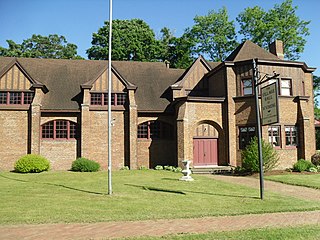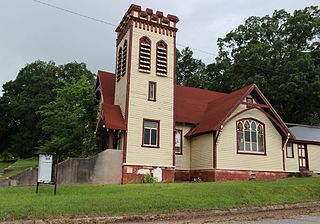
The Albany Presbyterian Church and Rectory, also known as Whitespires, is a historic church building in Albany, Oregon, United States. It was built in 1891 in the Carpenter Gothic style. It was listed on the National Register of Historic Places (NRHP) in 1979. Although individually listed in the NRHP, it is located within the Monteith Historic District.

The Ralston Community Clubhouse was built in 1914 as a community school in Ralston, Wyoming. It was abandoned as a school in 1922 when Ralston consolidated its school with the neighboring Powell school district. The Powell district offered the school to the Ralston Community Club in 1930. The clubhouse became the social center of Ralston, serving as a community meeting hall and polling place. It was particularly important to local women's organizations.

Brick Presbyterian Church is a historic Presbyterian church in Perry, Wyoming County, New York. The Gothic Revival-style church was built in 1909 of randome ashlar Pennsylvania limestone. It consists of a central octagonal structure housing the sanctuary surrounded by wings that give the structure a cruciform appearance. It features a massive square crenellated bell tower. It is a product of the Buffalo architectural firm of Green & Wicks.

Wyoming Village Historic District is a national historic district located at the Village of Wyoming in Wyoming County, New York. The district covers about 45 acres (180,000 m2) and is organized as a New England village around a small triangular village green. The T-shaped district includes approximately 72 historic registered structures along two principal streets, Main and Academy Streets.

First Presbyterian Church is a historic church located at 120 East State Street in Trenton, Mercer County, New Jersey, United States. The church's first congregation got together in 1712 and their first church was built in 1726. The church building and churchyard cemetery were added to the National Register of Historic Places for their significance in architecture, politics, religion, and social history on September 9, 2005.

Luzerne Presbyterial Institute, also known as the Wyoming Institute is a historic church school on Institute Street in Wyoming, Pennsylvania. It was built in 1849 for use as a school, the Luzerne Presbyterial Institute, which closed in 1869. The building was then used as a Sunday school by the Wyoming Presbyterian Church. It was added to the National Register in 1979.

St. Paul's Episcopal Church in Evanston, Wyoming is a small church in the Carpenter Gothic style. The church was built in 1884–1885, and at the time was the only Protestant church in a community dominated by Mormons and Catholics. In its early history it hosted Lutherans, Methodists and Presbyterians in addition to its Episcopalian congregation.

Northside Presbyterian Church is a historic Presbyterian church at 923 Mississippi Avenue in Chattanooga, Tennessee, affiliated with the Presbyterian Church USA.

St. Paul's United Church of Christ of Laramie was founded in 1886 as the first German language congregation in Wyoming. The church building was listed on the National Register of Historic Places in 1983. The cornerstone was laid on July 13, 1890, three days after statehood. Clergy from Chicago and the local Christian, Methodist, Episcopal, Presbyterian and Baptist Churches participated in the ceremony, with an address by Dr. John Wesley Hoyt, former Governor of Wyoming Territory and at the time first president of the University of Wyoming. The building was completed and dedicated on January 18, 1891. It is the oldest church structure in Laramie continuously used by the same congregation. With its stained glass windows and heavy wooden furnishings, St. Paul's is reminiscent of rural German churches. Those elaborate windows and its many simplified Gothic elements make the building unique among Lutheran churches in Wyoming.

Mullens Historic District is a national historic district located at Mullens, Wyoming County, West Virginia. It encompasses 95 contributing buildings and one contributing structure in the central business district of Mullens. It also includes surrounding residential areas. Notable buildings include the Highlawn Baptist Church (1925), Old Presbyterian Church, Wyoming Hotel (1918), Bank of Mullens Building (1920), Masonic Hall Building (1924), Welch Apartment Building, Old Hospital / Webster Apartments, Smiley Department Store Building (1921), Piggly Wiggly Building (1929), Wyoming Theatre (1922), and Norfolk Southern Locomotive Repair Shop Building (1925).

France Memorial United Presbyterian Church is a historic Presbyterian church at 3rd and Cedar Streets in the city of Rawlins, Wyoming.

The River Street Historic District is a national historic district that is located in Wilkes-Barre, Pennsylvania.
Walter Ellsworth Ware was an American architect who established a firm in 1891 in Salt Lake City, Utah and practiced until 1949, over a period of almost 60 years. He designed numerous buildings of diverse styles and functions that remain standing, many of which are listed on the U.S. National Register of Historic Places.

The Greensboro History Museum, consisting of the former First Presbyterian Church of Greensboro and Smith Memorial Building, is a historic museum building located at 130 Summit Ave. in Greensboro, Guilford County, North Carolina. The former Presbyterian church was built in 1892 on the site of a former Confederate hospital, and is a Romanesque Revival style brick building with a cross gable roof and tower. The semi-circular, 11 bay, Smith Memorial Building was built in 1903. It features four octagonal sides and a tower. The memorial building was designed by the architect Charles Christian Hook (1870-1938). The church and memorial building were connected and the older structures modified and renovated in 1938. Also located on the property is the First Presbyterian Church cemetery, established in 1831, after the first church was built on land that was donated by Jesse H. Lindsay. The church vacated the property in 1929, and in 1937-1938 it was renovated and enlarged as the Richardson Civic Center and donated to the city of Greensboro. It subsequently housed the Greensboro Public Library, the Greensboro Historical Museum, and the Greensboro Art Center. The historic building functions as one part of the current, larger Greenboro History Museum.

The First Presbyterian Church is a historic Presbyterian church at 2nd and Hempstead Streets in Nashville, Arkansas. The building is now home to the E. A. Williams Chapel and Museum, and is owned and operated by the Howard County Historical Society. The building is a single-story wood-frame structure, constructed in 1912 by builder Elijah Alexander Williams. It is roughly L-shaped, and exhibits a combination of Queen Anne and Stick styling that is rare in southwestern Arkansas.

Rock Spring Presbyterian Church is a historic Presbyterian church at 1824 Piedmont Avenue NE in Atlanta, Georgia. Designed by Atlanta architect Charles H. Hopson, it was built in 1923 and additions were made to the rear in 1952 and in 1963. It is cross-shaped in plan and Tudor Revival in style.

Central Presbyterian Church is a historic church at 201 Washington Street SW in Atlanta, Georgia. It was founded in 1885 and was added to the National Register of Historic Places in 1986.

Fairfield Presbyterian Church is a historic Presbyterian Church in America congregation in the Fairton section of Fairfield Township in Cumberland County, New Jersey. It was founded in 1680 when a log church was built on the banks of the Cohansey Creek, and it is the oldest existing congregation currently within the PCA. This log church was replaced by a New England style frame building sometime between 1713 and 1715.

The Downtown Rawlins Historic District comprises the historic center of Rawlins, Wyoming. It comprises the area between Second and Sixth Streets and Front to Buffalo Streets and along 5th Street between West Spruce and West Cedar. The town owes much of its living to the Union Pacific Railway, which took advantage of spring in the Rawlins area to establish services there.

The Old Stone Church is a historic sandstone church located in Kingwood Township in Hunterdon County, New Jersey, United States. It was built in 1837 and is now owned by the First Unitarian Universalist Fellowship of Hunterdon County. The church, described using its historic name, Old Stone Presbyterian Church in Kingwood, was added to the National Register of Historic Places on January 25, 2018 for its significance in architecture. The earlier church located here was a smaller stone building built in 1755, called the Old Stone Meetinghouse. The stones from this church were probably used to build the current one. The Kingwood congregation was established in 1728 and grew during the First Great Awakening, with Gilbert Tennent and George Whitefield preaching here in 1739.























